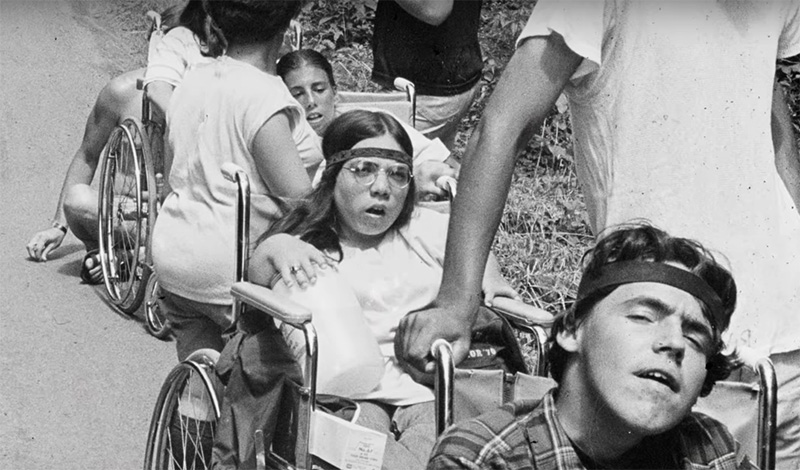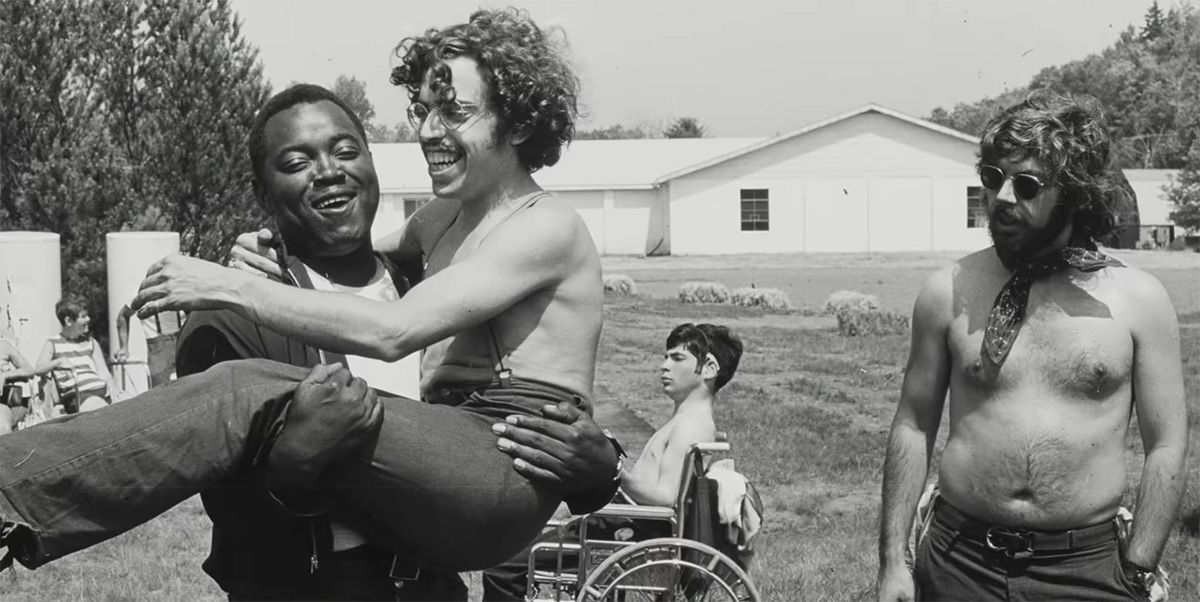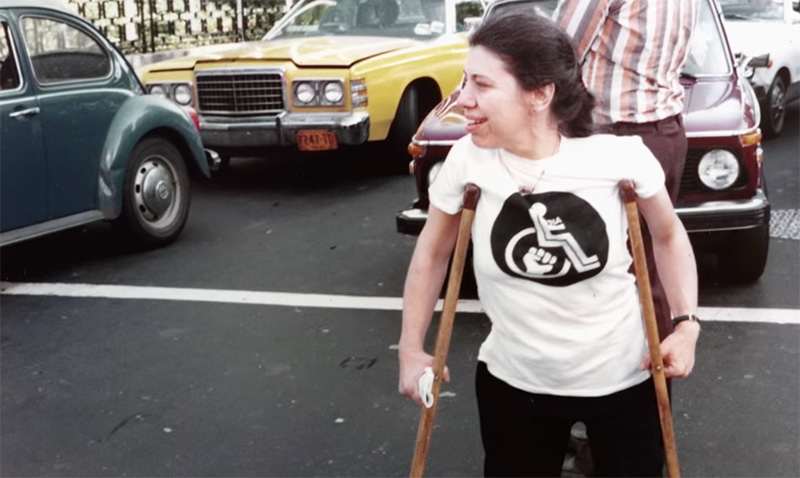In the opening scenes of Crip Camp, a documentary available on Netflix, school buses pull into the entrance of Jened, a summer camp in the New York Catskills. When the doors open, campers emerge into the sunshine, some on crutches, some in wheelchairs, all in one way or another “handicapped,” to use the brutal and dismissive language common in 1971, when the early archival footage used by the documentary makers was shot.
In the company of young staff counsellors who display most of the visual markers of ’70s counterculture — long hair, beards, tie-dyed T-shirts and beads — these kids swim in a pool; play vigorous, adapted games of baseball and soccer; and discover the pleasures of participatory democracy, encounter groups, dancing and summer romance.
All of this plays out to a soundtrack of vintage rock and folk music like Richie Havens’ “Freedom” and the Grateful Dead’s “Truckin'” that will delight viewers of a certain age.
Some of the kids we meet in those opening scenes went on to organize a national civil rights movement in the U.S. to establish and extend the rights of the disabled, a movement as remarkable for its tactical innovations, relentless courage and significant victories as it is for its relative invisibility in mainstream, recorded history.
Crip Camp, the product of an ongoing partnership between Netflix and Michelle and Barack Obama’s production company, Higher Ground, is an important corrective to that invisibility. It’s also a film with important lessons for anyone who wants to organize politically to make the world a fairer place and to protect our fragile environment from the catastrophic attacks of climate change and pollution. It is likely the most important movie you will watch on Netflix this season.
People who live with physical and developmental disabilities often remain nearly invisible to their abled peers today, despite the fact that disabled people comprise nearly 15 per cent of the world’s population, according to the UN. Statistics Canada says that 22 per cent of Canadians over 15 live with disabilities.
Additionally, those of us who spend much of our lives able-bodied are likely to experience some mobility and function challenges as we age — leading one of the passengers I drove around during the 20 years I was in charge of a HandyDart bus in Vancouver to refer to me and other non-disabled folks as the “temporarily able-bodied.” (Now that I’m in my 70s, I am learning every day just how right she was!)

But the kids we meet in Crip Camp learned more quickly than me just how poorly the world was organized to meet their needs. They were born into a world where public buildings had no wheelchair ramps or entrances, and sidewalks lacked the curb cuts that make it possible to get around in the city in a wheelchair. In other words, a world where their segregated invisibility was an unnoticed-to-most aspect of their daily, lived reality.
The first half of Crip Camp illuminates what these activists-to-be experienced at Jened. The footage it depends on emerges from the work of another archetypal ’70s experiment, the New York-based People’s Video Theater.
Armed with clunky video cameras, the young videographers embedded at Jened and recorded both formal meetings and informal, private moments. These scenes are woven together with news footage and, later, interviews with grown-up kids we’ve seen experience the revolutionary impact of respect, agency and support at the camp, as they become activists and reflect on their foundational time at Crip Camp.
One of the co-producers of the documentary, Jim LeBrecht, was a camper at Jened in 1971. His experiences there inspired him to move to Berkeley, California and help create the movement he celebrates in the film. We see him as an angelic teen with long curls darting around camp in his wheelchair and enjoying time with his first girlfriend.
“What we saw at that camp was that our lives could be better,” he says during an interview filmed in 2019. “We were brothers and sisters there. Jened exposed me to the outside world.”

Another key figure that emerged from Camp Jened and went on to help change the world was counsellor Judy Heumann, whose story makes up one of the moving narratives and dramatic throughlines of Crip Camp.
When the New York City Department of Education refused to hire Heumann — who had herself been denied a public-school education due to her disability — to teach in the city’s schools, she went to court in 1970.
Heumann won a landmark decision that forced the city to hire her as the school district’s first disabled teacher. (The judge who ruled in Heumann’s favour knew a bit about discrimination herself. Judge Constance Baker Motley had, earlier in her career, acted for the National Association for the Advancement of Colored People in landmark cases against racially segregated schools, including the iconic Brown v. Board of Education.)
Later, Heumann was one of the first Camp Jened gang to move to Berkeley where she helped found the groundbreaking Center for Independent Living.
When the Carter administration stalled on campaign promises to enforce the disability rights that had been guaranteed in theory by the 1972 Rehabilitation Act, Heumann and her accomplices created a series of media-grabbing direct actions, including a month-long occupation of federal offices in San Francisco and a pilgrimage to Washington to bring their message to the president.
The news footage of the occupation and the lobbying trip to D.C. provide some of the most exciting and instructive moments in this remarkable documentary. We see the occupiers’ almost palpable sense of community as they settle into the federal offices, their creative use of their special talents to get around official sabotage, like using sign language out the window to communicate with supporters outside after the FBI cut off the phones in the occupied building.
We also see how the occupiers reach out to possible allies and generate community support. We see them develop a relationship with Evan White, a local TV journalist who was the only one in mainstream media to provide extended coverage of their struggles and victory. White’s coverage provides much of the archival footage used in this portion of the documentary.
This fierce, joyful energy helps to explain how Heumann and her gang were able to enlist solidarity actions from the Black Panthers, gay and lesbian activists, unions, churches and other allies. The Machinists Union, for example, rented moving trucks to shuttle Heumann and her allies around D.C. on their protest rounds.
Eventually Carter’s beleaguered secretary of health, education and welfare caved to the pressure and authorized enforcement of the neglected rights language in Section 504 of the Rehabilitation Act, a law that was itself the result of lobbying and pressure organized earlier by Heumann and her accomplices. This enforcement meant a significant improvement in the way the rights of Americans living with disabilities were protected.
But this win was only a partial victory; Heumann and the movement she helped build went on to lobby for the adoption of the Americans with Disabilities Act in 1990.
The sweeping legislation has had an immense impact on the lives of Americans. It banned discrimination against people living with disabilities in employment, housing and transportation. It required communication companies to provide appropriate access for people with visual and hearing challenges.
Seven years after the act became law, Heumann and her allies gathered to celebrate the 20th anniversary of the Section 504 occupation of federal offices.
“It is no exaggeration to say that we each have participated in one of the greatest and most successful people’s movements in the 20th century,” Ken Stein, one of the original occupiers, said at its commemoration.

This American success story and the documentary that records it is of compelling interest to Canadian disability activists. Paul Caune, founder of Civil Rights Now and the source of the instructive epigram, “If you want the politicians to see the light, you need to turn up the heat,” told me that he viewed Crip Camp with mixed emotions.
“I felt joy at seeing people win,” he told me in early July, “and I felt shame and embarrassment about the disability movement in Canada.”
Caune told me that in his view, the recently passed Accessible BC Act was toothless and lacked the enforcement powers created by the American legislation.
The U.S. is not a utopia for the disabled under the Americans with Disabilities Act, he adds — but he still thinks civil disobedience campaigns and aggressive litigation will be the best path forward, north of the border, to create enforceable rights for disabled people in Canada.
Civil disobedience can be alarming to those who maintain the status quo, but Crip Camp provides a compelling argument for fierce activism. At a moment when new generations of Indigenous land protectors, BIPOC activists, disability rights activists, feminists and advocates within queer communities are in the streets and in the courts fighting for their rights, often employing civil disobedience and often met with angry criticism from those who fear change, Crip Camp provides a useful antidote to those fearful voices.
Tim Louis, former Vancouver city councillor and perennial political activist who has been a wheelchair user for most of his life, told me that watching Crip Camp reinforced his conviction that disabled people “should make a fuss.”
“We need to self-advocate,” he said. “We don’t need to be rehabilitated. Society does.”
While agreeing with Caune’s point about the need for more progress in Canada on rights for those living with disabilities, he does point with pride and satisfaction to changes that have already been made, especially in his hometown of Vancouver — which now features curb cuts and HandyDart services Louis says makes it something of a “disability heaven.”
“As a movement, we have moved beyond what we could have imagined back then,” he told me.
Crip Camp is a remarkable, funny and moving documentary that will appeal to anyone who has lived with the challenges of physical or developmental disability — and every activist who, today, is wondering how to replicate, or advance, its successes. ![]()
Read more: Rights + Justice















Tyee Commenting Guidelines
Comments that violate guidelines risk being deleted, and violations may result in a temporary or permanent user ban. Maintain the spirit of good conversation to stay in the discussion.
*Please note The Tyee is not a forum for spreading misinformation about COVID-19, denying its existence or minimizing its risk to public health.
Do:
Do not: